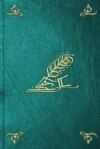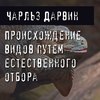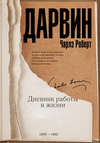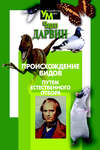Читать книгу: «More Letters of Charles Darwin — Volume 1», страница 35
LETTER 337. TO J.D. HOOKER. Down, December 10th {1856}.
It is a most tiresome drawback to my satisfaction in writing that, though I leave out a good deal and try to condense, every chapter runs to such an inordinate length. My present chapter on the causes of fertility and sterility and on natural crossing has actually run out to 100 pages MS., and yet I do not think I have put in anything superfluous...
I have for the last fifteen months been tormented and haunted by land-mollusca, which occur on every oceanic island; and I thought that the double creationists or continental extensionists had here a complete victory. The few eggs which I have tried both sink and are killed. No one doubts that salt water would be eminently destructive to them; and I was really in despair, when I thought I would try them when torpid; and this day I have taken a lot out of the sea-water, after exactly seven days' immersion. (337/1. This method of dispersal is not given in the "Origin"; it seems, therefore, probable that further experiments upset the conclusion drawn in 1856. This would account for the satisfaction expressed in the following year at the discovery of another method, on which Darwin wrote to Sir J.D. Hooker: "The distribution of fresh-water molluscs has been a horrid incubus to me, but I think I know my way now. When first hatched they are very active, and I have had thirty or forty crawl on a dead duck's foot; and they cannot be jerked off, and will live fifteen or even twenty-four hours out of water" ("Life and Letters," II., page 93). The published account of these experiments is in the "Origin," Edition I., page 385.) Some sink and some swim; and in both cases I have had (as yet) one come to life again, which has quite astonished and delighted me. I feel as if a thousand-pound weight was taken off my back. Adios, my dear, kind friend.
I must tell you another of my profound experiments! {Frank} said to me: "Why should not a bird be killed (by hawk, lightning, apoplexy, hail, etc.) with seed in its crop, and it would swim?" No sooner said than done: a pigeon has floated for thirty days in salt water with seeds in its crop, and they have grown splendidly; and to my great surprise even tares (Leguminosae, so generally killed by sea-water), which the bird had naturally eaten, have grown well. You will say gulls and dog-fish, etc., would eat up the carcase, and so they would 999 times out of a thousand, but one might escape: I have seen dead land-birds in sea-drift.
LETTER 338. ASA GRAY TO CHARLES DARWIN.
(338/1. In reply to Darwin's letter given in "Life and Letters," II., page 88.)
Cambridge, Mass., February 16th, 1857.
I meant to have replied to your interesting letter of January 1st long before this time, and also that of November 24th, which I doubt if I have ever acknowledged. But after getting my school-book, Lessons in Botany, off my hands — it taking up time far beyond what its size would seem to warrant — I had to fall hard at work upon a collection of small size from Japan — mostly N. Japan, which I am only just done with. As I expected, the number of species common to N. America is considerably increased in this collection, as also the number of closely representative species in the two, and a pretty considerable number of European species too. I have packed off my MSS. (though I hardly know what will become of it), or I would refer you to some illustrations. The greater part of the identical species (of Japan and N. America) are of those extending to or belonging to N.W. coast of America, but there are several peculiar to Japan and E. U. States: e.g. our Viburnum lantanoides is one of Thunberg's species. De Candolle's remarkable case of Phryma, which he so dwells upon, turns out, as Dr. Hooker said it would, to be only one out of a great many cases of the same sort. (Hooker brought Monotropa uniflora, you know, from the Himalayas; and now, by the way, I have it from almost as far south, i.e., from St. Fee, New Granada)...
Well, I never meant to draw any conclusions at all, and am very sorry that the only one I was beguiled into should "rile" (338/2. "One of your conclusions makes me groan, viz., that the line of connection of the strictly alpine plants is through Greenland. I should extremely like to see your reasons published in detail, for it 'riles' me (this is a proper expression, is it not?) dreadfully" (Darwin to Gray, January 1st, 1857, "Life and Letters," II., page 89).) you, as you say it does, — that on page 73 of my second article: for if it troubles you it is not likely to be sound. Of course I had no idea of laying any great stress upon the fact (at first view so unexpected to me) that one-third of our alpine species common to Europe do not reach the Arctic circle; but the remark which I put down was an off-hand inference from what you geologists seem to have settled — viz., that the northern regions must have been a deal cooler than they are now — the northern limit of vegetation therefore much lower than now — about the epoch when it would seem probable that the existing species of our plants were created. At any rate, during the Glacial period there could have been no phaenogamous plants on our continent anywhere near the polar regions; and it seems a good rule to look in the first place for the cause or reason of what now is, in that which immediately preceded. I don't see that Greenland could help us much, but if there was any interchange of species between N. America and N. Europe in those times, was not the communication more likely to be in lower latitudes than over the pole?
If, however, you say — as you may have very good reasons for saying — that the existing species got their present diffusion before the Glacial epoch, I should have no answer. I suppose you must needs assume very great antiquity for species of plants in order to account for their present dispersion, so long as we cling — as one cannot but do — to the idea of the single birthplace of species.
I am curious to see whether, as you suggest, there would be found a harmony or close similarity between the geographical range in this country of the species common to Europe and those strictly representative or strictly congeneric with European species. If I get a little time I will look up the facts: though, as Dr. Hooker rightly tells me, I have no business to be running after side game of any sort, while there is so much I have to do — much more than I shall ever do probably — to finish undertakings I have long ago begun.
...As to your P.S. If you have time to send me a longer list of your protean genera, I will say if they seem to be protean here. Of those you mention: —
Salix, I really know nothing about.
Rubus, the N. American species, with one exception, are very clearly marked indeed.
Mentha, we have only one wild species; that has two pretty well-marked forms, which have been taken for species; one smooth, the other hairy.
Saxifraga, gives no trouble here.
Myosotis, only one or two species here, and those very well marked.
Hieracium, few species, but pretty well marked.
Rosa, putting down a set of nominal species, leaves us four; two of them polymorphous, but easy to distinguish...
LETTER 339. TO J.D. HOOKER. Down, {1857?}
One must judge by one's own light, however imperfect, and as I have found no other book (339/1. A. De Candolle's "Geographie Botanique," 1855.) so useful to me, I am bound to feel grateful: no doubt it is in main part owing to the concentrated light of the noble art of compilation. (339/2. See Letter 49.) I was aware that he was not the first who had insisted on range of Monocots. (Was not R. Brown {with} Flinders?) (339/3. M. Flinders' "Voyage to Terra Australis in 1801-3, in H.M.S. 'Investigator'"; with "Botanical Appendix," by Robert Brown, London, 1814.), and I fancy I only used expression "strongly insisted on," — but it is quite unimportant.
If you and I had time to waste, I should like to go over his {De Candolle's} book and point out the several subjects in which I fancy he is original. His remarks on the relations of naturalised plants will be very useful to me; on the ranges of large families seemed to me good, though I believe he has made a great blunder in taking families instead of smaller groups, as I have been delighted to find in A. Gray's last paper. But it is no use going on.
I do so wish I could understand clearly why you do not at all believe in accidental means of dispersion of plants. The strongest argument which I can remember at this instant is A. de C., that very widely ranging plants are found as commonly on islands as over continents. It is really provoking to me that the immense contrast in proportion of plants in New Zealand and Australia seems to me a strong argument for non-continuous land; and this does not seem to weigh in the least with you. I wish I could put myself in your frame of mind. In Madeira I find in Wollaston's books a parallel case with your New Zealand case — viz., the striking absence of whole genera and orders now common in Europe, and (as I have just been hunting out) common in Europe in Miocene periods. Of course I can offer no explanation why this or that group is absent; but if the means of introduction have been accidental, then one might expect odd proportions and absences. When we meet, do try and make me see more clearly than I do, your reasons.
LETTER 340. TO J.D. HOOKER. Down, November 14th {1858}.
I am heartily glad to hear that my Lyellian notes have been of the slightest use to you. (340/1. The Copley Medal was given to Sir Charles Lyell in 1858. Mr. Darwin supplied Sir J.D. Hooker, who was on the Council of the Royal Society, with notes for the reasons for the award. See Letter 69.) I do not think the view is exaggerated...
Your letter and lists have MOST DEEPLY interested me. First for less important point, about hermaphrodite trees. (340/2. See "Life and Letters," II., page 89. In the "Origin," Edition I., page 100, the author quotes Dr. Hooker to the effect that "the rule does not hold in Australia," i.e., that trees are not more generally unisexual than other plants. In the 6th edition, page 79, Darwin adds, "but if most of the Australian trees are dichogamous, the same result would follow as if they bore flowers with separated sexes.") It is enough to knock me down, yet I can hardly think that British N. America and New Zealand should all have been theoretically right by chance. Have you at Kew any Eucalyptus or Australian Mimosa which sets its seeds? if so, would it be very troublesome to observe when pollen is mature, and whether pollen-tubes enter stigma readily immediately that pollen is mature or some little time afterwards? though if pollen is not mature for some little time after flower opens, the stigma might be ready first, though according to C.C. Sprengel this is a rarer case. I wrote to Muller for chance of his being able and willing to observe this.
Your fact of greater number of European plants (N.B. — But do you mean greater percentage?) in Australia than in S. America is astounding and very unpleasant to me; for from N.W. America (where nearly the same flora exists as in Canada?) to T. del Fuego, there is far more continuous high land than from Europe to Tasmania. There must have, I should think, existed some curious barrier on American High-Road: dryness of Peru, excessive damp of Panama, or some other confounded cause, which either prevented immigration or has since destroyed them. You say I may ask questions, and so I have on enclosed paper; but it will of course be a very different thing whether you will think them worth labour of answering.
May I keep the lists now returned? otherwise I will have them copied.
You said that you would give me a few cases of Australian forms and identical species going north by Malay Archipelago mountains to Philippines and Japan; but if these are given in your "Introduction" this will suffice for me. (340/3. See Hooker's "Introductory Essay," page l.)
Your lists seem to me wonderfully interesting.
According to my theoretical notions, I am not satisfied with what you say about local plants in S.W. corner of Australia (340/4. Sir Joseph replied in an undated letter: "Thanks for your hint. I shall be very cautious how I mention any connection between the varied flora and poor soil of S.W. Australia...It is not by the way only that the species are so numerous, but that these and the genera are so confoundedly well marked. You have, in short, an incredible number of VERY LOCAL, WELL MARKED genera and species crowded into that corner of Australia." See "Introductory Essay to the Flora of Tasmania," 1859, page li.), and the seeds not readily germinating: do be cautious on this; consider lapse of time. It does not suit my stomach at all. It is like Wollaston's confined land-snails in Porto Santo, and confined to same spots since a Tertiary period, being due to their slow crawling powers; and yet we know that other shell-snails have stocked a whole country within a very few years with the same breeding powers, and same crawling powers, when the conditions have been favourable to the life of the introduced species. Hypothetically I should rather look at the case as owing to — but as my notions are not very simple or clear, and only hypothetical, they are not worth inflicting on you.
I had vowed not to mention my everlasting Abstract (340/5. The "Origin of Species" was abbreviated from the MS. of an unpublished book.) to you again, for I am sure I have bothered you far more than enough about it; but as you allude to its previous publication I may say that I have chapters on Instinct and Hybridism to abstract, which may take a fortnight each; and my materials for Palaeontology, Geographical Distribution and Affinities being less worked up, I daresay each of these will take me three weeks, so that I shall not have done at soonest till April, and then my Abstract will in bulk make a small volume. I never give more than one or two instances, and I pass over briefly all difficulties, and yet I cannot make my Abstract shorter, to be satisfactory, than I am now doing, and yet it will expand to small volume.
LETTER 341. TO J.D. HOOKER. Down {November?} 27th {1858}.
What you say about the Cape flora's direct relation to Australia is a great trouble to me. Does not Abyssinia highland, (341/1. In a letter to Darwin, December 21st (?), 1858, Sir J.D. Hooker wrote: "Highlands of Abyssinia will not help you to connect the Cape and Australian temperate floras: they want all the types common to both, and, worse than that, India notably wants them. Proteaceae, Thymeleae, Haemodoraceae, Acacia, Rutaceae, of closely allied genera (and in some cases species), are jammed up in S.W. Australia, and C.B.S. {Cape of Good Hope}: add to this the Epacrideae (which are mere (paragraph symbol) of Ericaceae) and the absence or rarity of Rasaceae, etc., etc., and you have an amount {of} similarity in the floras and dissimilarity to that of Abyssinia and India in the same features that does demand an explanation in any theoretical history of Southern vegetation."), and the mountains on W. coast in some degree connect the extra-tropical floras of Cape and Australia? To my mind the enormous importance of the Glacial period rises daily stronger and stronger. I am very glad to hear about S.E. and S.W. Australia: I suspected after my letter was gone that the case must be as it is. You know of course that nearly the same rule holds with birds and mammals. Several years ago I reviewed in the "Annals of Natural History," (341/2. "Annals and Mag. of Nat. Hist." Volume XIX., 1847, pages 53-56, an unsigned review of "A Natural History of the Mammalia," by G.R. Waterhouse, Volume I. The passage referred to is at page 55: "The fact of South Australia possessing only few peculiar species, it having been apparently colonised from the eastern and western coasts, is very interesting; for we believe that Mr. Robert Brown has shown that nearly the same remark is applicable to the plants; and Mr. Gould finds that most of the birds from these opposite shores, though closely allied, are distinct. Considering these facts, together with the presence in South Australia of upraised modern Tertiary deposits and of extinct volcanoes, it seems probable that the eastern and western shores once formed two islands, separated from each other by a shallow sea, with their inhabitants generically, though not specifically, related, exactly as are those of New Guinea and Northern Australia, and that within a geologically recent period a series of upheavals converted the intermediate sea into those desert plains which are now known to stretch from the southern coast far northward, and which then became colonised from the regions to the east and west." On this point see Hooker's "Introductory Essay to the Flora of Tasmania," page ci, where Jukes' views are discussed. For an interesting account of the bearings of the submergence of parts of Australia, see Thiselton-Dyer, "R. Geogr. Soc. Jour." XXII., No. 6.) Waterhouse's "Mammalia," and speculated that these two corners, now separated by gulf and low land, must have existed as two large islands; but it is odd that productions have not become more mingled; but it accords with, I think, a very general rule in the spreading of organic beings. I agree with what you say about Lyell; he learns more by word of mouth than by reading.
Henslow has just gone, and has left me in a fit of enthusiastic admiration of his character. He is a really noble and good man.
LETTER 342. TO G. BENTHAM. Down, December 1st {1858?}.
I thank you for so kindly taking the trouble of writing to me, on naturalised plants. I did not know of, or had forgotten, the clover case. How I wish I knew what plants the clover took the place of; but that would require more accurate knowledge of any one piece of ground than I suppose any one has. In the case of trees being so long-lived, I should think it would be extremely difficult to distinguish between true and new spreading of a species, and a rotation of crop. With respect to your idea of plants travelling west, I was much struck by a remark of yours in the penultimate "Linnean Journal" on the spreading of plants from America near Behring Straits. Do you not consider so many more seeds and plants being taken from Europe to America, than in a reverse direction, would go some way to account for comparative fewness of naturalised American plants here? Though I think one might wildly speculate on European weeds having become well fitted for cultivated land, during thousands of years of culture, whereas cultivated land would be a new home for native American weeds, and they would not consequently be able to beat their European rivals when put in contest with them on cultivated land. Here is a bit of wild theory! (342/1. See Asa Gray, "Scientific Papers," 1889, Volume II., page 235, on "The Pertinacity and Predominance of Weeds," where the view here given is adopted. In a letter to Asa Gray (November 6th, 1862), published in the "Life and Letters," II., page 390, Darwin wrote: "Does it not hurt your Yankee pride that we thrash you so confoundedly? I am sure Mrs. Gray will stick up for your own weeds. Ask her whether they are not more honest downright good sort of weeds.")
But I did not sit down intending to scribble thus; but to beg a favour of you. I gave Hooker a list of species of Silene, on which Gartner has experimentised in crossing: now I want EXTREMELY to be permitted to say that such and such are believed by Mr. Bentham to be true species, and such and such to be only varieties. Unfortunately and stupidly, Gartner does not append author's name to the species.
Thank you heartily for what you say about my book; but you will be greatly disappointed; it will be grievously too hypothetical. It will very likely be of no other service than collocating some facts; though I myself think I see my way approximately on the origin of species. But, alas, how frequent, how almost universal it is in an author to persuade himself of the truth of his own dogmas. My only hope is that I certainly see very many difficulties of gigantic stature.
If you can remember any cases of one introduced species beating out or prevailing over another, I should be most thankful to hear it. I believe the common corn-poppy has been seen indigenous in Sicily. I should like to know whether you suppose that seedlings of this wild plant would stand a contest with our own poppy; I should almost expect that our poppies were in some degree acclimatised and accustomed to our cornfields. If this could be shown to be so in this and other cases, I think we could understand why many not-trained American plants would not succeed in our agrarian habitats.
LETTER 343. TO J.D. HOOKER.
(343/1. Mr. Darwin used the knowledge of the spread of introduced plants in North America and Australia to throw light on the cosmic migration of plants. Sir J.D. Hooker apparently objected that it was not fair to argue from agrarian to other plants; he also took a view differing slightly from that of Darwin as to climatal and other natural conditions favouring introduced plants in Australia.)
Down, January 28th, 1859.
Thanks about glaciers. It is a pleasure and profit to me to write to you, and as in your last you have touched on naturalised plants of Australia, I suppose you would not dislike to hear what I can say in answer. At least I know you would not wish me to defer to your authority, as long as not convinced.
I quite agree to what you say about our agrarian plants being accustomed to cultivated land, and so no fair test. Buckman has, I think, published this notion with respect to North America. With respect to roadside plants, I cannot feel so sure that these ought to be excluded, as animals make roads in many wild countries. (343/2. In the account of naturalised plants in Australia in Sir J.D. Hooker's "Introductory Essay to the Flora of Tasmania," 1859, page cvi, many of the plants are marked "Britain — waste places," "Europe — cornfields," etc. In the same list the species which have also invaded North America — a large number — are given. On the margin of Darwin's copy is scribbled in pencil: "Very good, showing how many of the same species are naturalised in Australia and United States, with very different climates; opposed to your conclusion." Sir Joseph supposed that one chief cause of the intrusion of English plants in Australia, and not vice versa, was the great importation of European seed to Australia and the scanty return of Australian seed.)
I have now looked and found passage in F. Muller's (343/3. Ferdinand Muller.) letter to me, in which he says: "In the WILDERNESSES of Australia some European perennials are "advancing in sure progress," "not to be arrested," etc. He gives as instances (so I suppose there are other cases) eleven species, viz., 3. Rumex, Poterium sanguisorba, Potentilla anserina, Medicago sativa, Taraxacum officinale, Marrubium vulgare, Plantago lanceolata, P. major, Lolium perenne. All these are seeding freely. Now I remember, years and years ago, your discussing with me how curiously easily plants get naturalised on uninhabited islands, if ships even touch there. I remember we discussed packages being opened with old hay or straw, etc. Now think of hides and wool (and wool exported largely over Europe), and plants introduced, and samples of corn; and I must think that if Australia had been the old country, and Europe had been the Botany Bay, very few, very much fewer, Australian plants would have run wild in Europe than have now in Australia.
The case seems to me much stronger between La Plata and Spain.
Nevertheless, I will put in my one sentence on this head, illustrating the greater migration during Glacial period from north to south than reversely, very humbly and cautiously. (343/4. "Origin of Species," Edition I., page 379. Darwin refers to the facts given by Hooker and De Candolle showing a stronger migratory flow from north to south than in the opposite direction. Darwin accounts for this by the northern plants having been long subject to severe competition in their northern homes, and having acquired a greater "dominating power" than the southern forms. "Just in the same manner as we see at the present day that very many European productions cover the ground in La Plata, and in a lesser degree in Australia, and have to a certain extent beaten the natives; whereas extremely few southern forms have become naturalised in any part of Europe, though hides, wool, and other objects likely to carry seeds have been largely imported during the last two or three centuries from La Plata, and during the last thirty or forty years from Australia.')
I am very glad to hear you are making good progress with your Australian Introduction. I am, thank God, more than half through my chapter on geographical distribution, and have done the abstract of the Glacial part...
LETTER 344. TO J.D. HOOKER. Down, March 30th, 1859.
Many thanks for your agreeable note. Please keep the geographical MS. till you hear from me, for I may have to beg you to send it to Murray; as through Lyell's intervention I hope he will publish, but he requires first to see MS. (344/1. "The Origin of Species"; see a letter to Lyell in "Life and Letters," II., page 151.)
I demur to what you say that we change climate of the world to account for "migration of bugs, flies, etc." WE do nothing of the sort; for WE rest on scored rocks, old moraines, arctic shells, and mammifers. I have no theory whatever about cause of cold, no more than I have for cause of elevation and subsidence; and I can see no reason why I should not use cold, or elevation, or subsidence to explain any other phenomena, such as distribution. I think if I had space and time I could make a pretty good case against any great continental changes since the Glacial epoch, and this has mainly led me to give up the Lyellian doctrine as insufficient to explain all mutations of climate.
I was amused at the British Museum evidence. (344/2. This refers to the letter to Murchison (Letter 65), published with the evidence of the 1858 enquiry by the Trustees of the British Museum.) I am made to give my opinion so authoritatively on botanical matters!..
As for our belief in the origin of species making any difference in descriptive work, I am sure it is incorrect, for I did all my barnacle work under this point of view. Only I often groaned that I was not allowed simply to decide whether a difference was sufficient to deserve a name.
I am glad to hear about Huxley — a wonderful man.
LETTER 345. TO J.D. HOOKER. Wells Terrace, Ilkley, Otley, Yorkshire, Thursday {before December 9th, 1859}.
I have read your discussion (345/1. See "Introductory Essay," page c. Darwin did not receive this work until December 23rd, so that the reference is to proof-sheets.), as usual, with great interest. The points are awfully intricate, almost at present beyond the confines of knowledge. The view which I should have looked at as perhaps most probable (though it hardly differs from yours) is that the whole world during the Secondary ages was inhabited by marsupials, araucarias (Mem. — Fossil wood so common of this nature in South America (345/2. See Letter 6, Note.)), Banksia, etc.; and that these were supplanted and exterminated in the greater area of the north, but were left alive in the south. Whence these very ancient forms originally proceeded seems a hopeless enquiry.
Your remarks on the passage of the northern forms southward, and of the southern forms of no kinds passing northward, seem to me grand. Admirable, also, are your remarks on the struggle of vegetation: I find that I have rather misunderstood you, for I feared I differed from you, which I see is hardly the case at all. I cannot help suspecting that you put rather too much weight to climate in the case of Australia. La Plata seems to present such analogous facts, though I suppose the naturalisation of European plants has there taken place on a still larger scale than in Australia...
You will get four copies of my book — one for self, and three for the foreign botanists — in about ten days, or sooner; i.e., as soon as the sheets can be bound in cloth. I hope this will not be too late for your parcels.
When you read my volume, use your pencil and score, so that some time I may have a talk with you on any criticisms.
LETTER 346. TO HUGH FALCONER. Down, December 17th, {1859}.
Whilst I think of it, let me tell you that years ago I remember seeing in the Museum of the Geological Society a tooth of hippopotamus from Madagascar: this, on geographical and all other grounds, ought to be looked to. Pray make a note of this fact. (346/1. At a meeting of the Geological Society, May 1st, 1833, a letter was read from Mr. Telfair to Sir Alex. Johnstone, accompanying a specimen of recent conglomerate rock, from the island of Madagascar, containing fragments of a tusk, and part of a molar tooth of a hippopotamus ("Proc. Geol. Soc." 1833, page 479). There is a reference to these remains of hippopotamus in a paper by Mr. R.B. Newton in the "Geol. Mag." Volume X., 1893; and in Dr. Forsyth Major's memoir on Megaladapis Madagascariensis ("Phil. Trans. R. Soc." Volume 185, page 30, 1894).
Since this letter was written, several bones belonging to two or possibly three species of hippopotamus have been found in Madagascar. See Forsyth Major, "On the General Results of a Zoological Expedition to Madagascar in 1894-96" ("Proc. Zool. Soc." 1896, page 971.))
Покупайте книги и получайте бонусы в Литрес, Читай-городе и Буквоеде.
Участвовать в бонусной программе




















